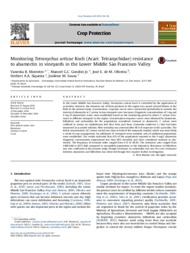Monitoring Tetranychus urticae Koch (Acari: Tetranychidae) resistance to abamectin in vineyards in the Lower Middle Sao Francisco Valley.
Monitoring Tetranychus urticae Koch (Acari: Tetranychidae) resistance to abamectin in vineyards in the Lower Middle Sao Francisco Valley.
Author(s): MONTEIRO, V. B.; GONDIM JÚNIOR, M. G. C.; OLIVEIRA, J. E. de M.; SIQUEIRA, H. A. A.; SOUSA, J. M.
Summary: In the Lower Middle Sao Francisco Valley, Tetranychus urticae Koch is controlled by the application of acaricides; however, the intensive use of these products in this region has caused control failures in the field. In the present study, concentrationeresponse curves were constructed periodically to monitor the toxicity of abamectin to T. urticae in two vineyards over two years. Diagnostic concentrations of 1 mg and 9 mg of abamectin/L water were established based on the monitoring period to detect T. urticae resistance in different vineyards in the region. Concentration-response curves were obtained for abamectin, bifenthrin and carbosulfan for the populations considered resistant to abamectin. T. urticae were confined in arenas on cotyledonary leaf discs from jack bean (Canavalia ensiformis L.) that had been immersed in acaricide solution. Mite mortality was assessed after 48 h of exposure to the acaricides. The lethal concentration (LC) values varied over time in both of the vineyards studied, which was most likely a result of crop management. An additional 35 vineyards were sampled, and 20 additional populations were established. The results indicated that 45% of the populations exposed to the 9 mg/L abamectin diagnostic concentration experienced less than 80% mortality and were considered resistant to abamectin. The frequency of resistant mites ranged from 4.1% to 80.4%. The resistance ratio ranged from 2406-fold to 8272-fold compared to susceptible populations in the laboratory. Resistance to bifenthrin was also confirmed in the present study, though resistance to carbosulfan was not. No cross-resistance between abamectin and bifenthrin was observed though this requires further investigation.
Publication year: 2015
Types of publication: Journal article
Unit: Embrapa Semi-arid Region
Observation
Some of Embrapa's publications are published as ePub files. To read them, use or download one of the following free software options to your computer or mobile device. Android: Google Play Books; IOS: iBooks; Windows and Linux: Calibre.
Access other publications
Access the Agricultural Research Database (BDPA) to consult Embrapa's full library collection and records.
Visit Embrapa Bookstore to purchase books and other publications sold by Embrapa.

